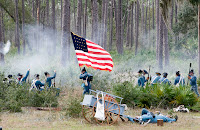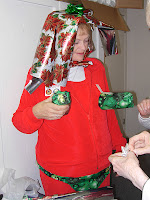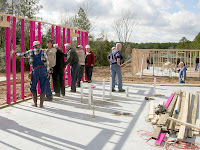Location: Bushnell, Florida
On December 28th, 1835, Seminole Indians fought U.S. soldiers under the command of Major Francis Dade, on a field which would eventually become part of Bushnell, Florida. The battle, the first of the Second Seminole War, is reenacted each year on the weekend after Christmas at the Dade Battlefield Historic Park.
 There were three Seminole Wars, (First: 1817 to 1818; Second: 1835 to 1842; Third: 1855 to 1858) but the Second is the one that has gone down in
There were three Seminole Wars, (First: 1817 to 1818; Second: 1835 to 1842; Third: 1855 to 1858) but the Second is the one that has gone down in
history as the longest lasting war in American history. The conflict between the U.S. government and the Seminoles began during the Revolutionary War when the Seminoles were recruited by the British to fight against Georgian settlements. Long story short, a treaty in the First Seminole War required all Seminoles to relocate, by 1835, to what is now Oklahoma. While many did, some understandably resisted being forced from their home and land. They fought back, attacking plantations and a militia wagon train. Major Dade, with 108 men, was dispatched to reinforce Fort King near Ocala. As he passed through the Bushnell area, the Seminoles ambushed and killed all but two of the soldiers, one of them subsequently dying within a short time. Major Dade was one of the casulties.
In January, 1836, Dade County in Florida (now Miami-Dade) was created and named for Major Francis Dade.
 As the reenactment began, the "Seminoles," who had minutes before arrived in golf carts, hid in the thickets. The narrator, who played the part of the eventual sole survivor (on the soldier's side), entered from a path on our left, followed by the two companies led by Major Dade. When they stopped to rest, the hidden Seminoles attacked, "killing" all but two of the soldiers. As the battle ensued, the narrator followed the action from his point of view, which was very much "us versus them," and interspersed with colorful language urging his fellow soldiers to kill the Indians. There was no narrator for the Seminoles.
As the reenactment began, the "Seminoles," who had minutes before arrived in golf carts, hid in the thickets. The narrator, who played the part of the eventual sole survivor (on the soldier's side), entered from a path on our left, followed by the two companies led by Major Dade. When they stopped to rest, the hidden Seminoles attacked, "killing" all but two of the soldiers. As the battle ensued, the narrator followed the action from his point of view, which was very much "us versus them," and interspersed with colorful language urging his fellow soldiers to kill the Indians. There was no narrator for the Seminoles.
 History is a complicated business. Although the victors write the story, there is always another side. The Seminole's story has not been lost, but I found this reenactment to be very one-sided. The only attempt at providing a balanced experience was a folk singer who, before the reenactment, sang some moving ballads about the Seminoles losing their homeland. I would have liked to have seen a joint narration, one soldier, one Seminole. As it was, it felt more like the old "Cowboys and Indians" games we used to play as children, where the cowboys were always good and the Indians were always bad. This was a bit different, though. This time the cowboys didn't have horses or ten-gallon hats, and the Indians didn't lose.
History is a complicated business. Although the victors write the story, there is always another side. The Seminole's story has not been lost, but I found this reenactment to be very one-sided. The only attempt at providing a balanced experience was a folk singer who, before the reenactment, sang some moving ballads about the Seminoles losing their homeland. I would have liked to have seen a joint narration, one soldier, one Seminole. As it was, it felt more like the old "Cowboys and Indians" games we used to play as children, where the cowboys were always good and the Indians were always bad. This was a bit different, though. This time the cowboys didn't have horses or ten-gallon hats, and the Indians didn't lose.
 On my last day in this park, the Barred Owl I have been searching for showed up! And I heard his story from some folks who were staying here last year:
On my last day in this park, the Barred Owl I have been searching for showed up! And I heard his story from some folks who were staying here last year: 






















